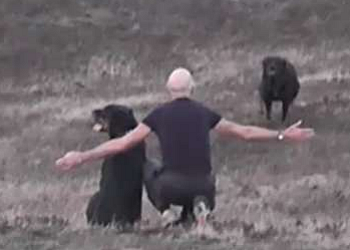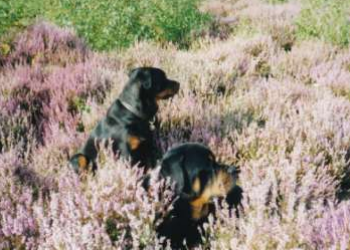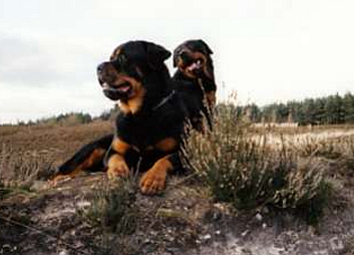DOG TRAINER/COMMUNICATOR
It's all about the dog
 So you want to give a dog a home? Good. And if you give it a good home marvellous. But this is a really serious decision.
So you want to give a dog a home? Good. And if you give it a good home marvellous. But this is a really serious decision.
A dog is not a fashion statement, it's not an accessory, it is not a "de rigueur accoutrement," like green wellies, for someone living in the country. A dog should NEVER be acquired on a whim. Sadly there are people with dogs who I wouldn't trust to look after a hibernating tortoise. Remember the slogan "a dog is for life not for Christmas," it's been around long enough.
A dog is an intelligent, intuitive, sentient and, if you take the trouble to learn to understand it, articulate creature. You will need long-term commitment if you are to responsibly take a dog into your home. And if you are not going to take the dog into your home and make it part of your family, your pack, do the dog a favour - forget it. I am utterly opposed to kenneling a single dog on its own outside the home.
Dogs are pack animals. They are very social creatures. They suffer if they are kept in isolation. They are companionable and they need to occupy a clearly defined position within the structure of the pack - your family.
Any dog left alone, regularly or for lenghty periods of time, will develop "behavioural" irregularities which may be displayed as destructiveness or, the big one, aggression. These BEHAVIOURS are NEVER the DOG'S FAULT!!!
Problems we encounter with domesticated creatures are caused by inappropriate human treatment, or by lack of understanding and an inability, therefore a failure, to COMMUNICATE with the ANIMAL in a WAY that IT UNDERSTANDS and makes sense to it. It is our responsibility to learn how to communicate effectively with any animal we intend to adopt.
On the basis of these elementary considerations you must select a dog that suits your requirements, of course, but more particularly a dog whose needs you can accomodate. For instance, if you are physically incapacitated and find walking difficult you shouldn't even be looking at a working dog that will only thrive if it can cover miles a day. If you are a naturally nervous person, you certainly do not want to introduce a large guarding breed to your home.
Unsuitable partnerships can only cause distress, even disaster. Every week there are horror stories in the news involving dogs. In just about every case the dog, whatever it has done, has been let down, betrayed even, by its human custodian who has been either inept, ignorant, irresponsible, abusive.
This week a truly tragic story emerged about the inquest on a woman walking two dogs in Wiltshire. She and the Dalmatian dragging her onto the unmanned rail crossing were both killed by a train, while the labrador, allegedly trying to pull her the other way, escaped and ran home.
The death of the woman was ghastly and so was the death of the dog - not to mention, and this is often overlooked, the appallingly traumatic effect upon the driver of the train!
But, and I hope I do not appear unduly insensitive here - I'm just trying to make a point, this catastrophe was NOT THE DOG'S FAULT!!!! If you cannot control your dog, if you have a dog that is incompatible with your ability, it is NOT THE DOG'S FAULT. It is your fault because it is YOUR RESPONSIBILITY.
If a person cannot control one dog, what on earth would lead him/her to conclude that taking two dogs out would be a good idea? I ride a horse out (using just a rope halter - NO bridle, NO bit in its mouth) lead another horse and take two free running dogs (rescued Rottweilers) with me, BUT I train horses and dogs and have real control over all four animals.
Training animals is SIMPLE, as long as you know what you are doing, but it is NOT necessarily EASY.
So here are a few helpful hints to SUCCESSFUL DOG TRAINING based on 35 years of study and practice.
We must be able to control our dog and to do so we must become accountable, responsible. We must be open minded and more patient than we ever thought possible. We need to be kind (but firm), even-handed, considerate, absolutely consistent, predictable and operate with complete clarity.
I cannot emphasise this point enough - to be effective with your dog ( or any other animal ), we need to COMMUNICATE in a way that IT UNDERSTANDS. It's not about us, it's ALL ABOUT the DOG. We must be PREPARED to LEARN and the more we know the better we will be with our animals. And that's not rocket science.
We need to establish our authority from the moment we take charge of the dog and the dog will be much happier when it understands its position in the "pack." Don't automatically respond to the dog's demands for attention, we decide when it's attention time.
Talk to your dog. Your voice is a wonderful instrument. Learn to use its range effectively to deliver your message - convey affection, encourage, console, get attention, give a command and, if necessary, reprimand.
 You also need to learn how to interpret and employ body-language in communicating with your dog. Make life easier for yourself AND for your DOG.
You also need to learn how to interpret and employ body-language in communicating with your dog. Make life easier for yourself AND for your DOG.
If the dog has a long name (three syllables - or more), abbreviate the name or give it a new one. When you need a quick response from your dog, you have to be emphatic. You don't want to be involved in a conversation rolling out the dog's name. "Bill" is much better than "Ballyhoo."
Remember YOU are TRAINING your DOG ALL THE TIME it is WITH YOU whether INTENTIONALLY (good) or UNWITTINGLY (bad news - and it happens all too often). You have got to keep your wits about you. If you are not in charge many dogs will try to take over and it may be something as simple and apparently (to you) inconsequential as letting the dog pull the tug toy out of your hands. It may mean nothing to you, but it means plenty to the dog!
That is why you need to get each aspect of your dog's training right and you MUST use repetition, repetition, repetition, with rewards initially, to establish and reinforce desirable behaviours. And you are going to need to keep reinforcing the lessons "ad infinitum." This may mean, with a dog that has been neglected or abused, giving hundreds of commands a day - day in, day out! Are you prepared to stay the course and really look after the dog's best interests? Let's hope so.
You must also discourage undesirable behaviours by ignoring them or, if necessary, correcting them. NO means NO. Say "NO" with meaning. That means APPROPRIATELY employing your VOICE, FACIAL EXPRESSION and BODY LANGUAGE.
Teach your dog to sit. Teach your dog to stay. Teach your dog to come. Teach your dog the down position Teach your dog to retrieve an item but particularly Teach your dog to leave, drop, release its grip on ANYTHING! Teach your dog to walk/run to heel ON A LOOSE LEAD and Teach your dog to walk/run to heel OFF the lead. You must be absolutely clear, plain, unambiguous in your commands. "Sit Down" is not clear, plain, unambiguous to your dog.
 It is two commands, yet how often do you hear people say "sit down" to their dog?
To enhance your position of authority, and always as a matter of course with an assertive dog,
insist the dog passes through any door after you,
gets in and out of the car only when you tell it to.
NEVER let the dog precede you up the stairs, if indeed you even allow the dog upstairs. Height confers rank in the wolf/wild dog pack. You don't want a dog looking down at you. It's one of those things that can mean plenty to an assertive/dominant dog.
Needless to say I would NEVER let an assertive/dominant dog onto the bed - which of course territorially represents the very epicentre of the "den", your Home!!
Do not feed your dog before you eat if there are any control issues. Again food is highly significant to the dog, with the "ALPHA" always eating the choicest parts of the kill before the rest of the pack can feed.
Having considered all of those "training" requirements, do remember that dogs love to PLAY.
It is two commands, yet how often do you hear people say "sit down" to their dog?
To enhance your position of authority, and always as a matter of course with an assertive dog,
insist the dog passes through any door after you,
gets in and out of the car only when you tell it to.
NEVER let the dog precede you up the stairs, if indeed you even allow the dog upstairs. Height confers rank in the wolf/wild dog pack. You don't want a dog looking down at you. It's one of those things that can mean plenty to an assertive/dominant dog.
Needless to say I would NEVER let an assertive/dominant dog onto the bed - which of course territorially represents the very epicentre of the "den", your Home!!
Do not feed your dog before you eat if there are any control issues. Again food is highly significant to the dog, with the "ALPHA" always eating the choicest parts of the kill before the rest of the pack can feed.
Having considered all of those "training" requirements, do remember that dogs love to PLAY.
You want to have fun and your dog can always learn through play. Remember though, particularly if you have an assertive dog, that while you may be a playmate, you must still ALWAYS be in CONTROL. There are lots of "toys" around that will entertain, occupy, even challenge your dog. Check them out. It is always a good idea for your dog to have his own space in the home where he/she is uninterrupted. A corner perhaps with a pad, a duvet, a basket, a place where your dog can sleep, rest, retreat for "down time." Unless you intend to breed dogs, and why would you if you are a novice owner, have your dog neutered.
And finally in this short synopsis work hard with your dog - repetition, reinforcement, loads of praise for a job well done. Love your dog lots and it will always be there for you. You do not need to, and should not, wind your dog up. Any moron can hype a dog up, but the trick is being able to calm a dog down.
To reiterate (again), remember dogs need and enjoy lots of exercise appropriate to the breed. They need mental stimulation. They enjoy play and most of them love toys. Let them chase balls, "kongs", etc - best not to throw sticks for them, these can cause nasty accidents.
Socialise your dog with people and other dogs as often as you can and go to dog training classes, at least in the early days.
Don't overfeed your dog and don't feed rubbish.
Follow these simple guidelines and you and your dog will be fine. Remember It's ALL ABOUT the DOG! It is SIMPLE, but it ISN'T always EASY.
Thank you for reading this. Thank you for helping a dog.
Good luck and very best wishes, Tim Laskey.
Take a look at these training videos for more instructional techniques, you can do great things
with dogs and have a lot of fun.
Just for the record, I've rescued and retrained first Dobermanns and then
Rottweilers
for about 35 years.
Copyright © Tim Laskey